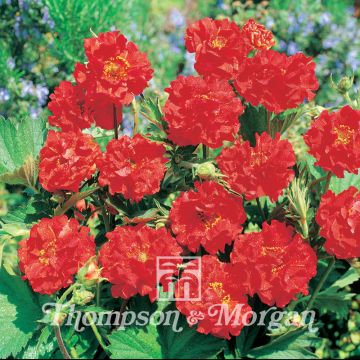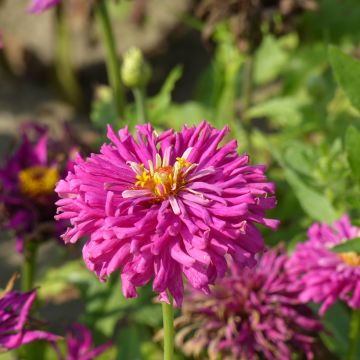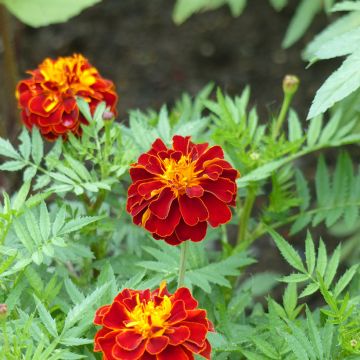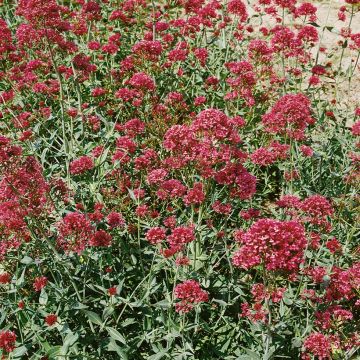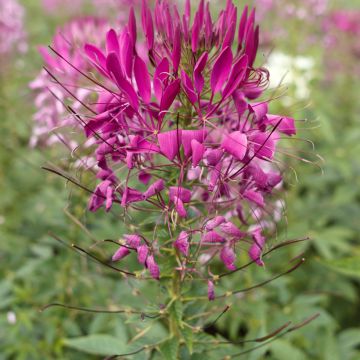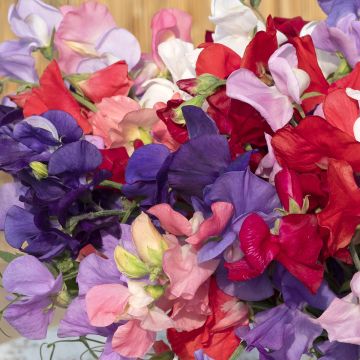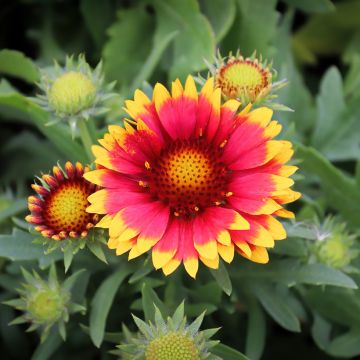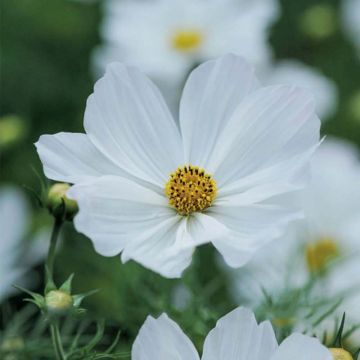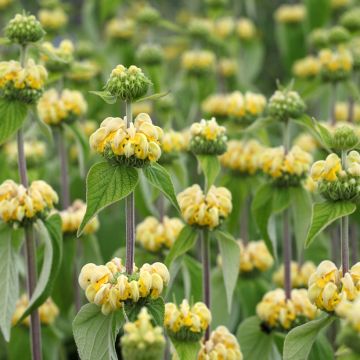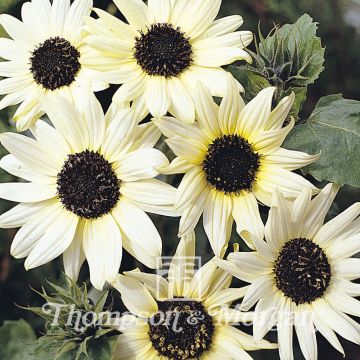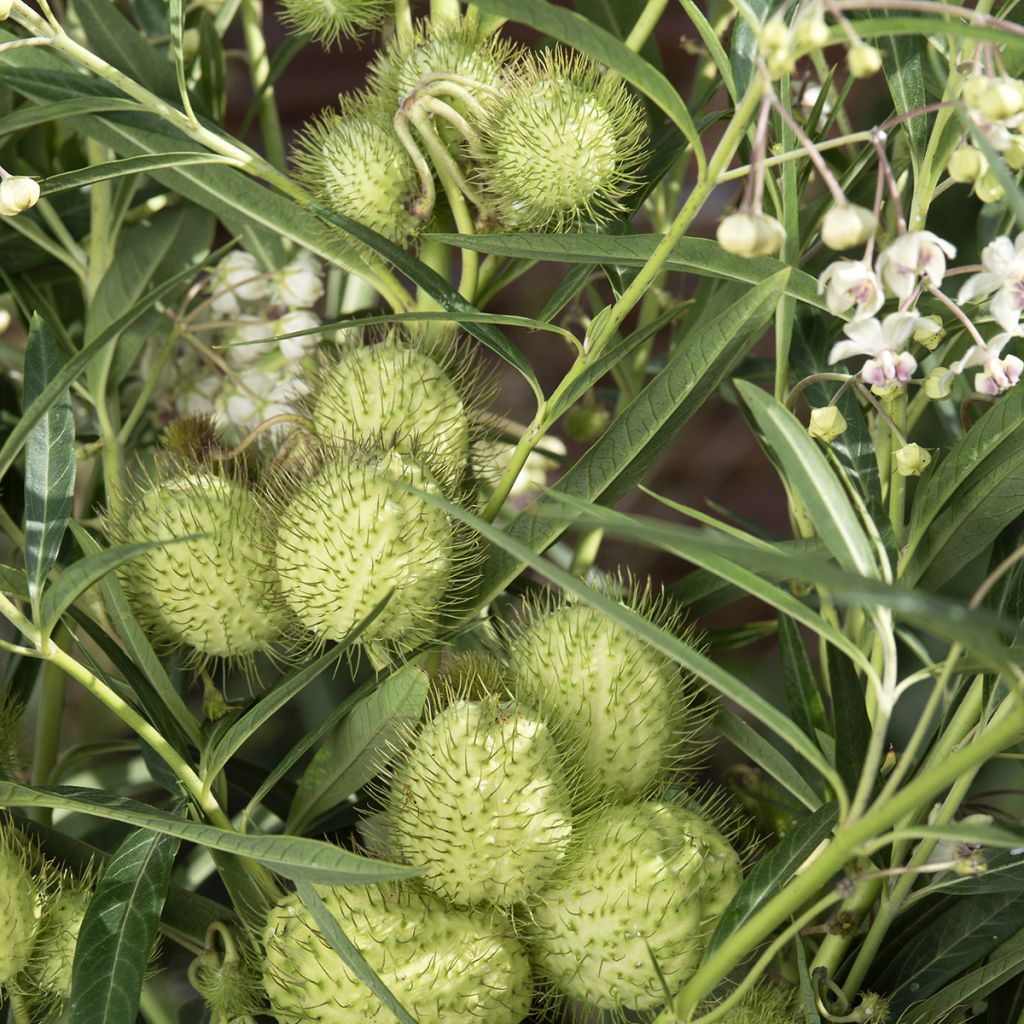

Gomphocarpus fruticosus - Narrowleaf Cottonbush seeds
Gomphocarpus fruticosus - Narrowleaf Cottonbush seeds
Gomphocarpus fruticosus Cottonbush
Narrowleaf Cottonbush, Swan Plant, Balloon Plant, Hairy Balls
This item cannot be shipped to the selected country
Dispatch by letter from €3.90
More information
Schedule delivery date,
and select date in basket
This plant carries a 6 months recovery warranty
More information
We guarantee the quality of our plants for a full growing cycle, and will replace at our expense any plant that fails to recover under normal climatic and planting conditions.
Seed-only orders are dispatched by sealed envelope. The delivery charge for seed-only orders is €3.90.
Does this plant fit my garden?
Set up your Plantfit profile →
Description
Gomphocarpus fruticosus is also known by the synonym Asclepias fruticosa. It is a perennial or shrub capable of reaching a height of 2m (7ft) by forming woody stems. In late spring, the plant blooms in trailing corymbs, which are decorative and formed by small white and mauve bicoloured flowers. Curious green fruits, swollen and adorned with small flexible thorns, follow, adding an ornamental touch to the season. It adapts to most well-drained soils, but is not very hardy outside of southern regions.
Gomphocarpus belongs to the Asclepiadaceae family, like Stephanotis or Hoya, commonly grown as indoor plants in our climate. There are several dozen species of Gomphocarpus, whose name comes from the Greek words "gomphos" meaning nail and "karpos" meaning fruit, due to the morphology of their fruits. Gomphocarpus fruticosus is native to southern Africa, Ethiopia, and South Africa, where it mainly grows in fallow lands, uncultivated areas and gravel pits along watercourses. Introduced as an ornamental plant worldwide, it has escaped from gardens and has become invasive in many countries, such as Australia and Mediterranean countries.
This fast-growing plant forms a clump reaching between 1.50m (5ft) and 2m (7ft) high with a spread of 1m (3ft). This evergreen shrub produces numerous upright and branched stems, adorned with narrow foliage. The leaves are dark green on the upper side, lighter on the underside, lanceolate and very thin, measuring from 4 to 12cm (2 to 5in) long and only 1cm (0in) to 1.5cm (1in) wide. They are arranged in whorls of three or opposite pairs. The stems, which turn woody with age, contain a toxic sap.
Towards the end of May, depending on the climate, the plant produces very decorative small flowers, approximately 10 to 13mm (0 to 1in) in diameter, grouped in trailing corymbs of 5 to 10 units. The flowers have a corolla consisting of five waxy, mauve to light pink petals, sometimes cream white, and a calyx of five star-shaped white sepals. The overall structure is very sculptural and ornamental, and the flowering period extends over several months, often until September.
The flowers are pollinated by insects and are followed by curiously swollen fruits covered in small flexible, non-prickly thorns, resembling a porcupine fish stranded in the garden. These green fruits have real decorative interest. They turn brown when ripe and eventually split open to release the seeds, which, equipped with a small tuft of bristles, are dispersed by the wind. Through this mechanism, the plant is capable of colonising large areas in regions where winters are mild enough for it to survive, it is hardy to temperatures of approximately -5°C (23°F).
With foliage resembling that of certain willows, exotic-looking flowers and strange fruits, Gomphocarpus fruticosus is undoubtedly a curious plant. This poisonous beauty can be associated with Euphorbias, plants with equally remarkable patterns and colours. It can also be accompanied by Salvia leucantha, the Mexican Sage with a very architectural silhouette of spikes of blue and white bicoloured flowers standing like cobras ready to strike.
Report an error about the product description
Flowering
Foliage
Plant habit
Safety measures
Botanical data
Gomphocarpus
fruticosus
Cottonbush
Apocynaceae (Asclepiadaceae)
Narrowleaf Cottonbush, Swan Plant, Balloon Plant, Hairy Balls
South Africa
ingestion
Cette plante est toxique si elle est ingérée volontairement ou involontairement.
Ne la plantez pas là où de jeunes enfants peuvent évoluer, et lavez-vous les mains après l'avoir manipulée.
Pensez à conserver l'étiquette de la plante, à la photographier ou à noter son nom, afin de faciliter le travail des professionnels de santé.
Davantage d'informations sur https://plantes-risque.info
Other Flower seeds
Planting and care
Sow in spring, maintaining a temperature of at least 18-20°C (64.4-68°F). The seeds do not require any special treatment and will germinate in about two weeks. Use a tray filled with special seed compost or even perlite, place the seeds on the surface and keep the substrate moist but not too wet. Place the tray in a propagator, indoors or in a heated shelter. When the young plants have 5 to 6 leaves, they can be transplanted into individual pots or directly into the garden if the soil is warm. Growth is fast and flowering appears as early as the second year.
Gomphocarpus likes the sun and requires well-drained soil that does not retain too much water. It likes moist soil but also withstands dry conditions quite well. It prefers neutral to chalky soils but can also adapt to more acidic soils. The plant cannot tolerate winters that are too cold. In the south, it adapts very well, even too well, and can easily naturalise and become invasive! It is therefore best in these regions to remove faded flowers to prevent seed formation.
Sowing period
Intended location
This item has not been reviewed yet - be the first to leave a review about it.
Haven't found what you were looking for?
Hardiness is the lowest winter temperature a plant can endure without suffering serious damage or even dying. However, hardiness is affected by location (a sheltered area, such as a patio), protection (winter cover) and soil type (hardiness is improved by well-drained soil).

Photo Sharing Terms & Conditions
In order to encourage gardeners to interact and share their experiences, Promesse de fleurs offers various media enabling content to be uploaded onto its Site - in particular via the ‘Photo sharing’ module.
The User agrees to refrain from:
- Posting any content that is illegal, prejudicial, insulting, racist, inciteful to hatred, revisionist, contrary to public decency, that infringes on privacy or on the privacy rights of third parties, in particular the publicity rights of persons and goods, intellectual property rights, or the right to privacy.
- Submitting content on behalf of a third party;
- Impersonate the identity of a third party and/or publish any personal information about a third party;
In general, the User undertakes to refrain from any unethical behaviour.
All Content (in particular text, comments, files, images, photos, videos, creative works, etc.), which may be subject to property or intellectual property rights, image or other private rights, shall remain the property of the User, subject to the limited rights granted by the terms of the licence granted by Promesse de fleurs as stated below. Users are at liberty to publish or not to publish such Content on the Site, notably via the ‘Photo Sharing’ facility, and accept that this Content shall be made public and freely accessible, notably on the Internet.
Users further acknowledge, undertake to have ,and guarantee that they hold all necessary rights and permissions to publish such material on the Site, in particular with regard to the legislation in force pertaining to any privacy, property, intellectual property, image, or contractual rights, or rights of any other nature. By publishing such Content on the Site, Users acknowledge accepting full liability as publishers of the Content within the meaning of the law, and grant Promesse de fleurs, free of charge, an inclusive, worldwide licence for the said Content for the entire duration of its publication, including all reproduction, representation, up/downloading, displaying, performing, transmission, and storage rights.
Users also grant permission for their name to be linked to the Content and accept that this link may not always be made available.
By engaging in posting material, Users consent to their Content becoming automatically accessible on the Internet, in particular on other sites and/or blogs and/or web pages of the Promesse de fleurs site, including in particular social pages and the Promesse de fleurs catalogue.
Users may secure the removal of entrusted content free of charge by issuing a simple request via our contact form.
The flowering period indicated on our website applies to countries and regions located in USDA zone 8 (France, the United Kingdom, Ireland, the Netherlands, etc.)
It will vary according to where you live:
- In zones 9 to 10 (Italy, Spain, Greece, etc.), flowering will occur about 2 to 4 weeks earlier.
- In zones 6 to 7 (Germany, Poland, Slovenia, and lower mountainous regions), flowering will be delayed by 2 to 3 weeks.
- In zone 5 (Central Europe, Scandinavia), blooming will be delayed by 3 to 5 weeks.
In temperate climates, pruning of spring-flowering shrubs (forsythia, spireas, etc.) should be done just after flowering.
Pruning of summer-flowering shrubs (Indian Lilac, Perovskia, etc.) can be done in winter or spring.
In cold regions as well as with frost-sensitive plants, avoid pruning too early when severe frosts may still occur.
The planting period indicated on our website applies to countries and regions located in USDA zone 8 (France, United Kingdom, Ireland, Netherlands).
It will vary according to where you live:
- In Mediterranean zones (Marseille, Madrid, Milan, etc.), autumn and winter are the best planting periods.
- In continental zones (Strasbourg, Munich, Vienna, etc.), delay planting by 2 to 3 weeks in spring and bring it forward by 2 to 4 weeks in autumn.
- In mountainous regions (the Alps, Pyrenees, Carpathians, etc.), it is best to plant in late spring (May-June) or late summer (August-September).
The harvesting period indicated on our website applies to countries and regions in USDA zone 8 (France, England, Ireland, the Netherlands).
In colder areas (Scandinavia, Poland, Austria...) fruit and vegetable harvests are likely to be delayed by 3-4 weeks.
In warmer areas (Italy, Spain, Greece, etc.), harvesting will probably take place earlier, depending on weather conditions.
The sowing periods indicated on our website apply to countries and regions within USDA Zone 8 (France, UK, Ireland, Netherlands).
In colder areas (Scandinavia, Poland, Austria...), delay any outdoor sowing by 3-4 weeks, or sow under glass.
In warmer climes (Italy, Spain, Greece, etc.), bring outdoor sowing forward by a few weeks.

































